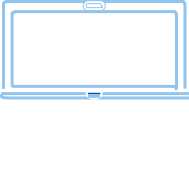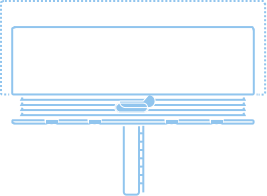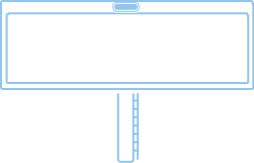How Long Should Your Billboard Ad Stay Up?
You’ve invested time and creativity into designing a great billboard ad. Now comes the crucial question: How long should it actually stay up? There’s no single magic number – a week is usually too short, a year is often too long. Getting the timing right is key to maximizing your impact and making sure your message sticks without fading into the background.
Let’s break down the factors that determine the ideal lifespan for your billboard campaign.

Why Timing Matters So Much
Think of billboards like guests at a party. A guest who arrives and leaves immediately might not be remembered. A guest who stays too long might overstay their welcome. Billboards work similarly:
- Too Short:Your audience might not see it enough times to truly notice, understand, or remember your message. It takes repeated exposure for an ad to sink in.
- Too Long:People get used to it. It becomes part of the scenery (“ad blindness”). The message loses its freshness and impact. People might even start to tune it out completely.
The sweet spot lies somewhere in the middle, where your ad gets enough views to build awareness and recall, but is replaced before it becomes stale.
Key Factors Influencing Billboard Duration
Here’s what you need to consider when deciding how long your billboard should grace the roadside or cityscape:
1. Your Campaign Goal:
-
- Brand Awareness (Launching something new, general presence):Longer durations (often 3-6 months) work well. It takes time to build recognition and familiarity.
- Promoting a Specific Event (Concert, Sale, Grand Opening):Shorter duration is essential. Aim for 2-8 weeks leading up to and during the event. Take it down immediately after.
- Driving Immediate Action (Call now, Visit website, Limited-time offer):Moderate duration (4-12 weeks), but must align perfectly with the offer’s availability. Urgency helps prevent staleness.
- Direct Response (Phone number, specific URL):Monitor performance closely. If calls/visits drop significantly after a peak, it might be time to rotate (often 8-12 weeks).
2. Your Message:
-
- Simple & Evergreen (Logo, tagline, basic service):Can potentially run longer (6-12 months), but still risks becoming invisible. Regular creative refreshes are highly recommended.
- Complex Offer or New Product:Needs sufficient time for comprehension (often 8-12 weeks minimum). Avoid overly complex messages on fast-moving routes.
- Time-Sensitive (Seasonal, Holiday, Sale):Duration is strictly dictated by the calendar. Run it only during the relevant period.
- Creative Execution:Highly unique or provocative creative might hold attention longer. Simpler designs might tire faster.
3. Your Audience & Location:
-
- Traffic Patterns:How often do the same people pass by? A major commuter highway sees the same drivers daily – ads fatigue faster (often 4-8 weeks max before needing a change). A tourist-heavy area sees constantly changing faces – ads can potentially run longer (3-6 months).
- Route Type:Fast-moving freeways allow for less complex messages and might benefit from shorter rotations to maintain impact. Slower city streets allow for slightly more detail and potentially longer runs.
- Competitive Clutter:Are there many billboards nearby? In a crowded environment, you might need to rotate your creative more frequently (every 6-8 weeks) to stand out.
4. Your Overall Strategy:
-
- Rotating Creative:This is often the best Keep the same location but change the ad message every 4-12 weeks. This combats ad blindness while maintaining presence. (e.g., Month 1: Brand intro. Month 2: Specific product feature. Month 3: Special offer).
- Market Saturation:Are you blanketing an area with multiple boards? Shorter rotations might be needed across the board to keep the overall campaign feeling fresh.
- Supporting Other Marketing:Does the billboard align with a TV, radio, or digital campaign? Its duration should match the flight dates of those other channels for maximum synergy.
The General Duration Sweet Spot (and Ranges)

Based on industry experience and the factors above, here are common effective ranges:
- Short-Term (2-8 weeks):Ideal for specific events, short sales, urgent calls to action, or testing a new location/creative. Requires high-impact, simple messaging.
- Medium-Term (2-4 months / 8-16 weeks):The MOST COMMON and often most effective range. Suitable for brand awareness pushes, new product launches, and offers with a moderate shelf-life. Allows for good frequency without high fatigue.
- Long-Term (4-12 months):Primarily for strong brand awareness with simple, evergreen messages in locations with high traffic turnover (like tourist spots). Crucially: Requires exceptional creative or a commitment to rotating the design within this period (e.g., changing the creative every 3 months on a 12-month contract). Running the exact same ad for 6+ months is rarely optimal.
Key Takeaways: Finding Your Perfect Duration
- It Depends:There’s no universal answer. Match duration to your specific goal, message, audience, and location.
- Avoid Extremes:Less than 4 weeks is often too short for impact. Over 6 months with no change is usually too long for effectiveness.
- 2-4 Months is the Sweet Spot:For most standard campaigns (awareness, product launch, moderate offer), 8-16 weeks is a highly effective starting point.
- Rotate, Rotate, Rotate:Changing your creative (even subtly) every 2-4 months is the single best strategy to maintain impact on a board for a longer overall contract. Think chapters in a story.
- Match the Calendar:Time-sensitive messages MUST align precisely with event dates.
- Monitor & Adapt:If possible, track responses or brand lift. Be ready to adjust timing or creative if results dip.
- Location Matters:High-frequency commuter routes need faster refreshes than tourist corridors.
Billboard Duration: Do’s and Don’ts
| Feature | Do’s | Don’ts |
| Planning | Define a clear campaign goal first. | Choose a duration randomly without considering your objective. |
| Research traffic patterns & audience frequency. | Assume everyone sees it the same number of times. | |
| Duration | Prioritize the 2-4 month (8-16 week) range for most campaigns. | Leave the same ad up for over 6 months without changing the creative. |
| Match duration EXACTLY to event dates or offer windows. | Run a “Back to School” ad in November. | |
| Creative | PLAN TO ROTATE CREATIVE every 2-4 months for long contracts. | Stick rigidly to one design for a year-long lease. |
| Use simpler messages for very short runs or fast traffic. | Put dense text and complex offers on high-speed highway boards. | |
| Management | Monitor response (calls, web traffic, coupon use) if possible. | “Set it and forget it” – never evaluate performance. |
| Consider competitor activity and adjust timing if clutter increases. | Ignore what other billboards nearby are doing. | |
| Flexibility | Negotiate flexible terms with the billboard company if possible. | Lock into a long, inflexible contract without rotation options. |
FAQs
Q: Can I run a billboard for just 1 week?
A:It’s possible, but rarely effective for awareness. Only consider this for an extremely urgent, hyper-local event (like a weekend festival) with a very simple message placed right where the audience will be immediately beforehand. Expect limited impact.
Q: What’s the absolute longest I should keep the same ad up?
A:While contracts can run a year or more, the same creative should ideally not run longer than 4-6 months without a refresh, even in high-turnover locations. Beyond that, severe ad blindness is highly likely. Rotation is key to longevity.
Q: How often should I rotate my creative?
A:For sustained presence, rotating every 8-12 weeks is a strong strategy. In highly competitive areas or high-frequency commute routes, rotating every 4-8 weeks might be better. Think of it as telling a new chapter of your story.
Q: Does digital billboard timing change things?
A:Yes! Digital billboards (DBBs) allow multiple advertisers to share one board in rapid rotation (e.g., every 6-10 seconds). Campaigns on DBBs typically run in shorter “flights” (often 2-4 weeks) because your ad appears many times per hour. Duration focuses on how many weeks you buy, not the physical presence. Frequency is achieved through repetition within each day.
Q: How can I tell if my ad has been up too long?
A:Look for signs: A noticeable drop in response (calls, website traffic from that area). Feedback from people saying “Oh yeah, that old ad…”. Seeing it yourself and realizing you barely notice it anymore. If your sales team or staff report hearing “I see your billboard everywhere!” less frequently.
Q: What if I have a very limited budget?
A:Focus is key. It’s better to run one well-placed board for a solid 2-3 months than spread the budget too thin across multiple boards for a shorter, less impactful period. Choose location wisely and craft a simple, high-impact message. Consider shorter rotations within your budget period if possible.
Conclusion: Timing is Part of the Message
Deciding how long your billboard ad should stay up isn’t just a logistical detail – it’s a strategic marketing decision that significantly impacts your return. Forget the idea of “set it and forget it.” Think of your billboard as a dynamic part of your conversation with potential customers.
By aligning your duration with your specific goals, audience patterns, and message type, and embracing the power of creative rotation, you ensure your billboard remains a vibrant, effective voice in the landscape, capturing attention and driving results throughout its life. Aim for that 2-4 month sweet spot, stay flexible, and keep the message fresh to make the most of your billboard investment.



















